Managing People Performance: A Sustainable Approach to Organizations
VerifiedAdded on 2023/05/31
|6
|1482
|461
Essay
AI Summary
This essay explores how to manage individual and team performance to achieve long-term sustainable organizational performance. It emphasizes that traditional management approaches focused solely on effectiveness are no longer sufficient in today's dynamic business environment. The paper suggests adopting a triple bottom line approach (people, planet, profit) to ensure that business operations benefit employees and the community, minimize environmental impact, and contribute to the company's financial viability. Key strategies for managers include fostering employee engagement by building trust, promoting clear communication, removing internal roadblocks, aligning metrics, and providing strategic training and development. The essay concludes that leading organizations are those that can effectively manage a series of projects, monitor their performance, and integrate them into the overall system, focusing on sustainability over stability and providing innovative services based on the latest practices and technologies. Desklib offers a platform to explore more solved assignments.
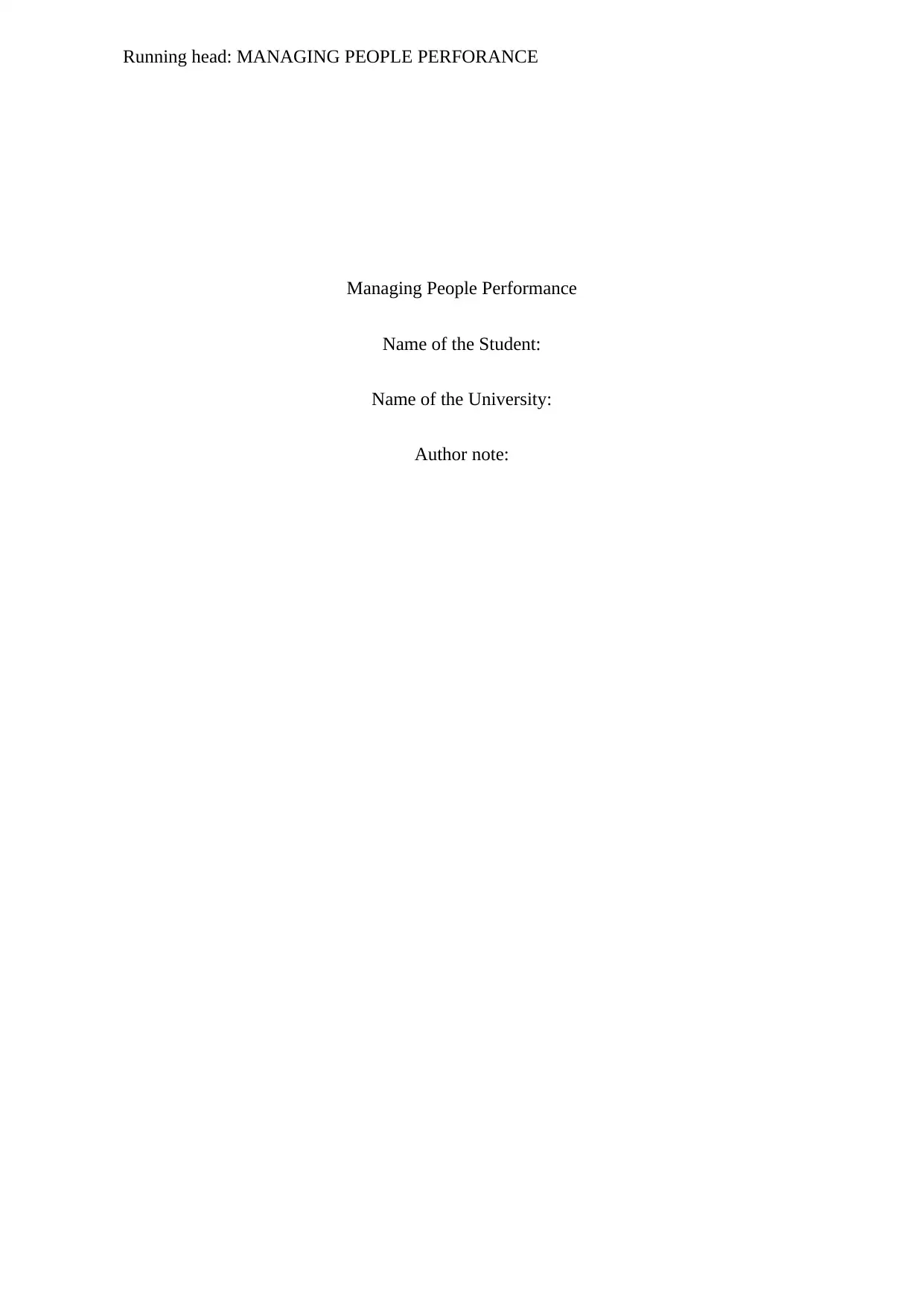
Running head: MANAGING PEOPLE PERFORANCE
Managing People Performance
Name of the Student:
Name of the University:
Author note:
Managing People Performance
Name of the Student:
Name of the University:
Author note:
Paraphrase This Document
Need a fresh take? Get an instant paraphrase of this document with our AI Paraphraser
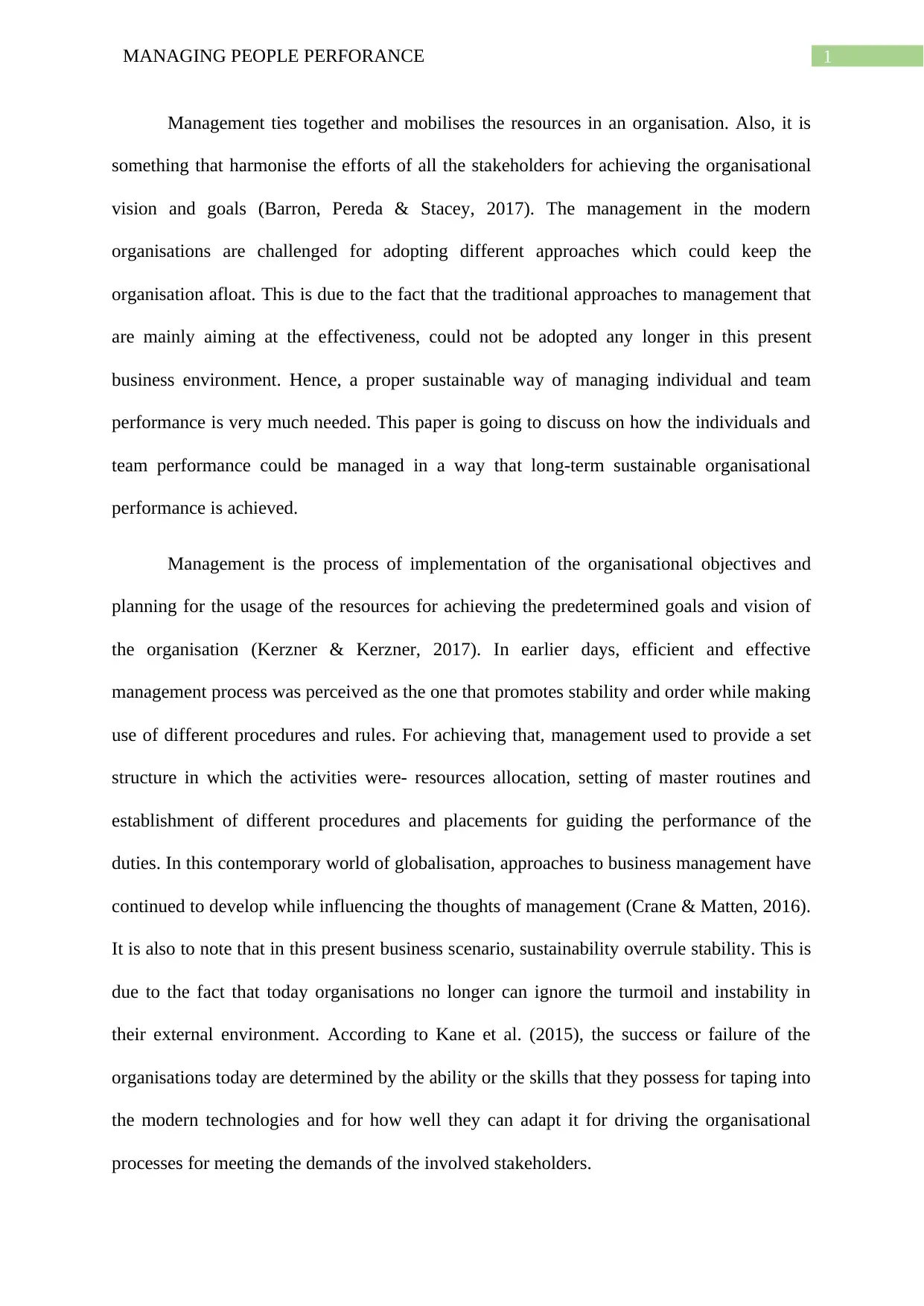
1MANAGING PEOPLE PERFORANCE
Management ties together and mobilises the resources in an organisation. Also, it is
something that harmonise the efforts of all the stakeholders for achieving the organisational
vision and goals (Barron, Pereda & Stacey, 2017). The management in the modern
organisations are challenged for adopting different approaches which could keep the
organisation afloat. This is due to the fact that the traditional approaches to management that
are mainly aiming at the effectiveness, could not be adopted any longer in this present
business environment. Hence, a proper sustainable way of managing individual and team
performance is very much needed. This paper is going to discuss on how the individuals and
team performance could be managed in a way that long-term sustainable organisational
performance is achieved.
Management is the process of implementation of the organisational objectives and
planning for the usage of the resources for achieving the predetermined goals and vision of
the organisation (Kerzner & Kerzner, 2017). In earlier days, efficient and effective
management process was perceived as the one that promotes stability and order while making
use of different procedures and rules. For achieving that, management used to provide a set
structure in which the activities were- resources allocation, setting of master routines and
establishment of different procedures and placements for guiding the performance of the
duties. In this contemporary world of globalisation, approaches to business management have
continued to develop while influencing the thoughts of management (Crane & Matten, 2016).
It is also to note that in this present business scenario, sustainability overrule stability. This is
due to the fact that today organisations no longer can ignore the turmoil and instability in
their external environment. According to Kane et al. (2015), the success or failure of the
organisations today are determined by the ability or the skills that they possess for taping into
the modern technologies and for how well they can adapt it for driving the organisational
processes for meeting the demands of the involved stakeholders.
Management ties together and mobilises the resources in an organisation. Also, it is
something that harmonise the efforts of all the stakeholders for achieving the organisational
vision and goals (Barron, Pereda & Stacey, 2017). The management in the modern
organisations are challenged for adopting different approaches which could keep the
organisation afloat. This is due to the fact that the traditional approaches to management that
are mainly aiming at the effectiveness, could not be adopted any longer in this present
business environment. Hence, a proper sustainable way of managing individual and team
performance is very much needed. This paper is going to discuss on how the individuals and
team performance could be managed in a way that long-term sustainable organisational
performance is achieved.
Management is the process of implementation of the organisational objectives and
planning for the usage of the resources for achieving the predetermined goals and vision of
the organisation (Kerzner & Kerzner, 2017). In earlier days, efficient and effective
management process was perceived as the one that promotes stability and order while making
use of different procedures and rules. For achieving that, management used to provide a set
structure in which the activities were- resources allocation, setting of master routines and
establishment of different procedures and placements for guiding the performance of the
duties. In this contemporary world of globalisation, approaches to business management have
continued to develop while influencing the thoughts of management (Crane & Matten, 2016).
It is also to note that in this present business scenario, sustainability overrule stability. This is
due to the fact that today organisations no longer can ignore the turmoil and instability in
their external environment. According to Kane et al. (2015), the success or failure of the
organisations today are determined by the ability or the skills that they possess for taping into
the modern technologies and for how well they can adapt it for driving the organisational
processes for meeting the demands of the involved stakeholders.
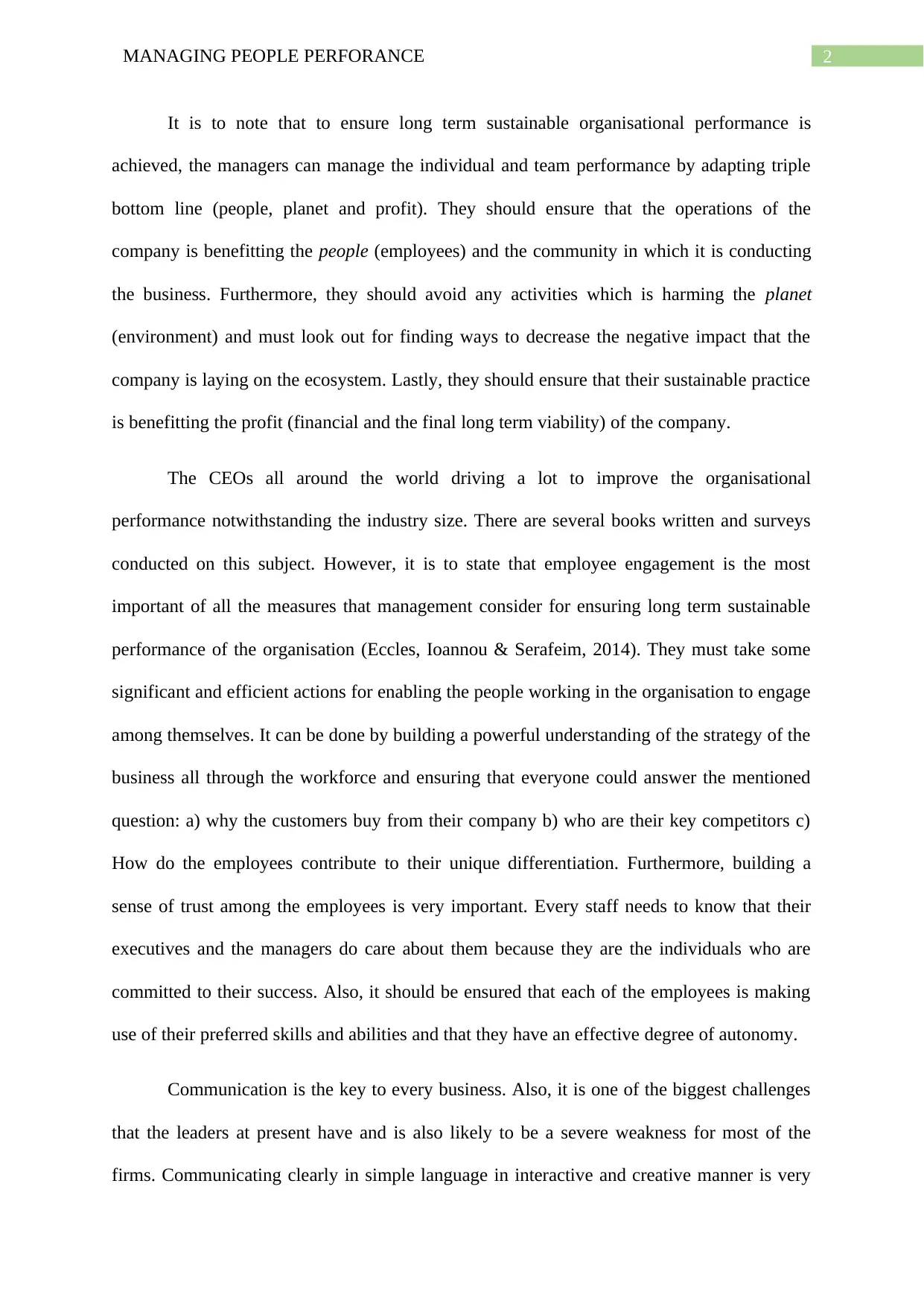
2MANAGING PEOPLE PERFORANCE
It is to note that to ensure long term sustainable organisational performance is
achieved, the managers can manage the individual and team performance by adapting triple
bottom line (people, planet and profit). They should ensure that the operations of the
company is benefitting the people (employees) and the community in which it is conducting
the business. Furthermore, they should avoid any activities which is harming the planet
(environment) and must look out for finding ways to decrease the negative impact that the
company is laying on the ecosystem. Lastly, they should ensure that their sustainable practice
is benefitting the profit (financial and the final long term viability) of the company.
The CEOs all around the world driving a lot to improve the organisational
performance notwithstanding the industry size. There are several books written and surveys
conducted on this subject. However, it is to state that employee engagement is the most
important of all the measures that management consider for ensuring long term sustainable
performance of the organisation (Eccles, Ioannou & Serafeim, 2014). They must take some
significant and efficient actions for enabling the people working in the organisation to engage
among themselves. It can be done by building a powerful understanding of the strategy of the
business all through the workforce and ensuring that everyone could answer the mentioned
question: a) why the customers buy from their company b) who are their key competitors c)
How do the employees contribute to their unique differentiation. Furthermore, building a
sense of trust among the employees is very important. Every staff needs to know that their
executives and the managers do care about them because they are the individuals who are
committed to their success. Also, it should be ensured that each of the employees is making
use of their preferred skills and abilities and that they have an effective degree of autonomy.
Communication is the key to every business. Also, it is one of the biggest challenges
that the leaders at present have and is also likely to be a severe weakness for most of the
firms. Communicating clearly in simple language in interactive and creative manner is very
It is to note that to ensure long term sustainable organisational performance is
achieved, the managers can manage the individual and team performance by adapting triple
bottom line (people, planet and profit). They should ensure that the operations of the
company is benefitting the people (employees) and the community in which it is conducting
the business. Furthermore, they should avoid any activities which is harming the planet
(environment) and must look out for finding ways to decrease the negative impact that the
company is laying on the ecosystem. Lastly, they should ensure that their sustainable practice
is benefitting the profit (financial and the final long term viability) of the company.
The CEOs all around the world driving a lot to improve the organisational
performance notwithstanding the industry size. There are several books written and surveys
conducted on this subject. However, it is to state that employee engagement is the most
important of all the measures that management consider for ensuring long term sustainable
performance of the organisation (Eccles, Ioannou & Serafeim, 2014). They must take some
significant and efficient actions for enabling the people working in the organisation to engage
among themselves. It can be done by building a powerful understanding of the strategy of the
business all through the workforce and ensuring that everyone could answer the mentioned
question: a) why the customers buy from their company b) who are their key competitors c)
How do the employees contribute to their unique differentiation. Furthermore, building a
sense of trust among the employees is very important. Every staff needs to know that their
executives and the managers do care about them because they are the individuals who are
committed to their success. Also, it should be ensured that each of the employees is making
use of their preferred skills and abilities and that they have an effective degree of autonomy.
Communication is the key to every business. Also, it is one of the biggest challenges
that the leaders at present have and is also likely to be a severe weakness for most of the
firms. Communicating clearly in simple language in interactive and creative manner is very
⊘ This is a preview!⊘
Do you want full access?
Subscribe today to unlock all pages.

Trusted by 1+ million students worldwide
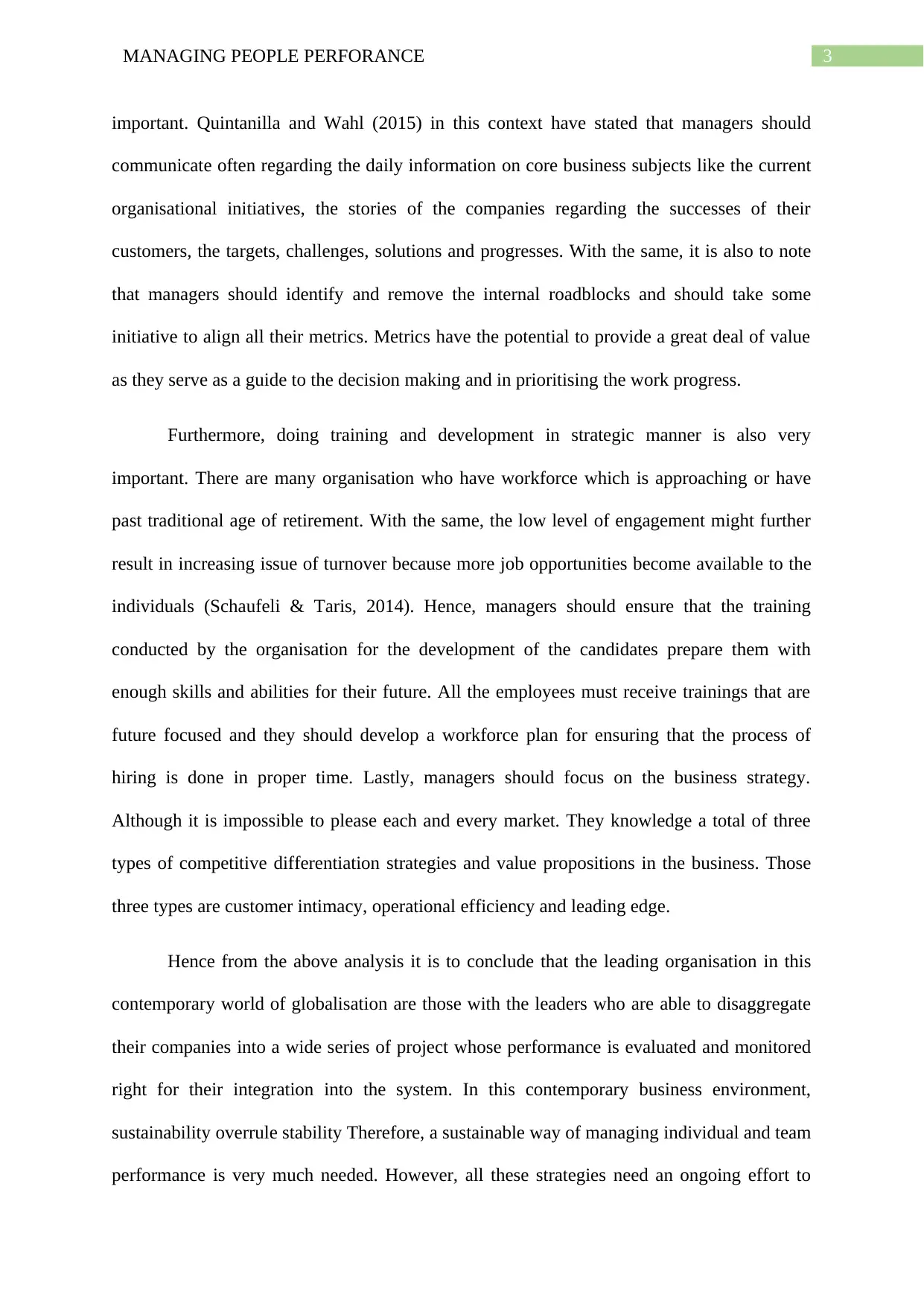
3MANAGING PEOPLE PERFORANCE
important. Quintanilla and Wahl (2015) in this context have stated that managers should
communicate often regarding the daily information on core business subjects like the current
organisational initiatives, the stories of the companies regarding the successes of their
customers, the targets, challenges, solutions and progresses. With the same, it is also to note
that managers should identify and remove the internal roadblocks and should take some
initiative to align all their metrics. Metrics have the potential to provide a great deal of value
as they serve as a guide to the decision making and in prioritising the work progress.
Furthermore, doing training and development in strategic manner is also very
important. There are many organisation who have workforce which is approaching or have
past traditional age of retirement. With the same, the low level of engagement might further
result in increasing issue of turnover because more job opportunities become available to the
individuals (Schaufeli & Taris, 2014). Hence, managers should ensure that the training
conducted by the organisation for the development of the candidates prepare them with
enough skills and abilities for their future. All the employees must receive trainings that are
future focused and they should develop a workforce plan for ensuring that the process of
hiring is done in proper time. Lastly, managers should focus on the business strategy.
Although it is impossible to please each and every market. They knowledge a total of three
types of competitive differentiation strategies and value propositions in the business. Those
three types are customer intimacy, operational efficiency and leading edge.
Hence from the above analysis it is to conclude that the leading organisation in this
contemporary world of globalisation are those with the leaders who are able to disaggregate
their companies into a wide series of project whose performance is evaluated and monitored
right for their integration into the system. In this contemporary business environment,
sustainability overrule stability Therefore, a sustainable way of managing individual and team
performance is very much needed. However, all these strategies need an ongoing effort to
important. Quintanilla and Wahl (2015) in this context have stated that managers should
communicate often regarding the daily information on core business subjects like the current
organisational initiatives, the stories of the companies regarding the successes of their
customers, the targets, challenges, solutions and progresses. With the same, it is also to note
that managers should identify and remove the internal roadblocks and should take some
initiative to align all their metrics. Metrics have the potential to provide a great deal of value
as they serve as a guide to the decision making and in prioritising the work progress.
Furthermore, doing training and development in strategic manner is also very
important. There are many organisation who have workforce which is approaching or have
past traditional age of retirement. With the same, the low level of engagement might further
result in increasing issue of turnover because more job opportunities become available to the
individuals (Schaufeli & Taris, 2014). Hence, managers should ensure that the training
conducted by the organisation for the development of the candidates prepare them with
enough skills and abilities for their future. All the employees must receive trainings that are
future focused and they should develop a workforce plan for ensuring that the process of
hiring is done in proper time. Lastly, managers should focus on the business strategy.
Although it is impossible to please each and every market. They knowledge a total of three
types of competitive differentiation strategies and value propositions in the business. Those
three types are customer intimacy, operational efficiency and leading edge.
Hence from the above analysis it is to conclude that the leading organisation in this
contemporary world of globalisation are those with the leaders who are able to disaggregate
their companies into a wide series of project whose performance is evaluated and monitored
right for their integration into the system. In this contemporary business environment,
sustainability overrule stability Therefore, a sustainable way of managing individual and team
performance is very much needed. However, all these strategies need an ongoing effort to
Paraphrase This Document
Need a fresh take? Get an instant paraphrase of this document with our AI Paraphraser
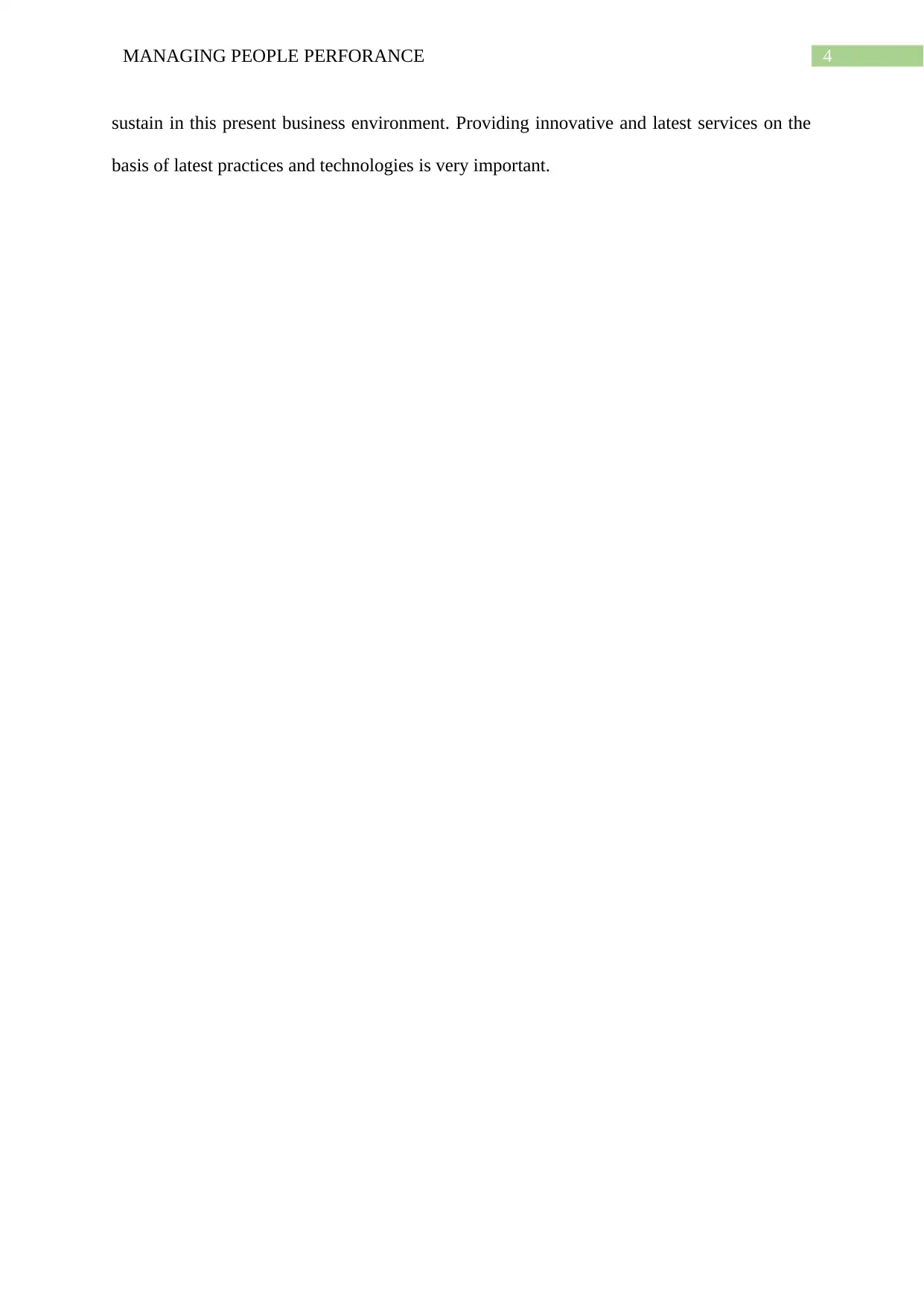
4MANAGING PEOPLE PERFORANCE
sustain in this present business environment. Providing innovative and latest services on the
basis of latest practices and technologies is very important.
sustain in this present business environment. Providing innovative and latest services on the
basis of latest practices and technologies is very important.
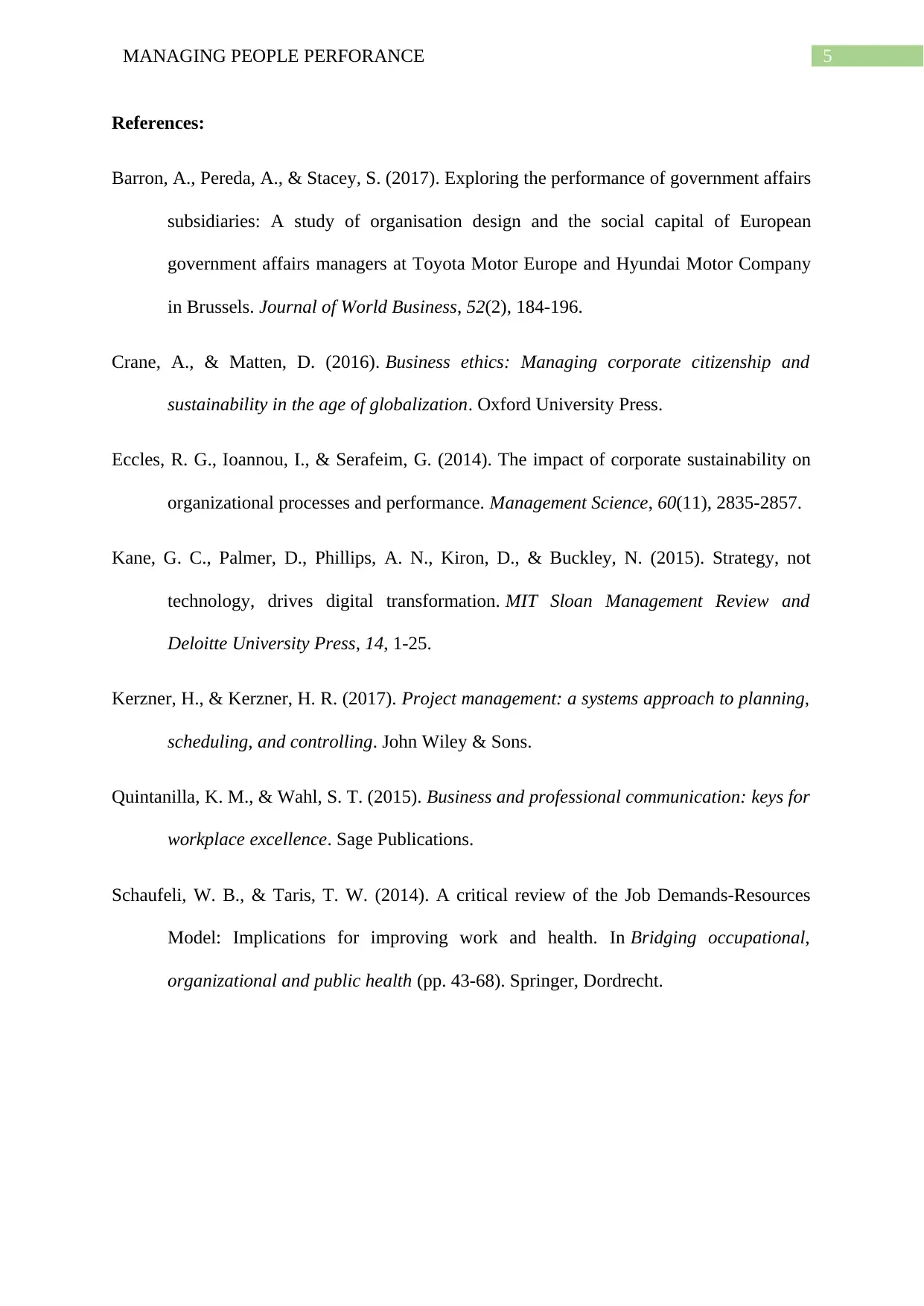
5MANAGING PEOPLE PERFORANCE
References:
Barron, A., Pereda, A., & Stacey, S. (2017). Exploring the performance of government affairs
subsidiaries: A study of organisation design and the social capital of European
government affairs managers at Toyota Motor Europe and Hyundai Motor Company
in Brussels. Journal of World Business, 52(2), 184-196.
Crane, A., & Matten, D. (2016). Business ethics: Managing corporate citizenship and
sustainability in the age of globalization. Oxford University Press.
Eccles, R. G., Ioannou, I., & Serafeim, G. (2014). The impact of corporate sustainability on
organizational processes and performance. Management Science, 60(11), 2835-2857.
Kane, G. C., Palmer, D., Phillips, A. N., Kiron, D., & Buckley, N. (2015). Strategy, not
technology, drives digital transformation. MIT Sloan Management Review and
Deloitte University Press, 14, 1-25.
Kerzner, H., & Kerzner, H. R. (2017). Project management: a systems approach to planning,
scheduling, and controlling. John Wiley & Sons.
Quintanilla, K. M., & Wahl, S. T. (2015). Business and professional communication: keys for
workplace excellence. Sage Publications.
Schaufeli, W. B., & Taris, T. W. (2014). A critical review of the Job Demands-Resources
Model: Implications for improving work and health. In Bridging occupational,
organizational and public health (pp. 43-68). Springer, Dordrecht.
References:
Barron, A., Pereda, A., & Stacey, S. (2017). Exploring the performance of government affairs
subsidiaries: A study of organisation design and the social capital of European
government affairs managers at Toyota Motor Europe and Hyundai Motor Company
in Brussels. Journal of World Business, 52(2), 184-196.
Crane, A., & Matten, D. (2016). Business ethics: Managing corporate citizenship and
sustainability in the age of globalization. Oxford University Press.
Eccles, R. G., Ioannou, I., & Serafeim, G. (2014). The impact of corporate sustainability on
organizational processes and performance. Management Science, 60(11), 2835-2857.
Kane, G. C., Palmer, D., Phillips, A. N., Kiron, D., & Buckley, N. (2015). Strategy, not
technology, drives digital transformation. MIT Sloan Management Review and
Deloitte University Press, 14, 1-25.
Kerzner, H., & Kerzner, H. R. (2017). Project management: a systems approach to planning,
scheduling, and controlling. John Wiley & Sons.
Quintanilla, K. M., & Wahl, S. T. (2015). Business and professional communication: keys for
workplace excellence. Sage Publications.
Schaufeli, W. B., & Taris, T. W. (2014). A critical review of the Job Demands-Resources
Model: Implications for improving work and health. In Bridging occupational,
organizational and public health (pp. 43-68). Springer, Dordrecht.
⊘ This is a preview!⊘
Do you want full access?
Subscribe today to unlock all pages.

Trusted by 1+ million students worldwide
1 out of 6
Related Documents
Your All-in-One AI-Powered Toolkit for Academic Success.
+13062052269
info@desklib.com
Available 24*7 on WhatsApp / Email
![[object Object]](/_next/static/media/star-bottom.7253800d.svg)
Unlock your academic potential
Copyright © 2020–2025 A2Z Services. All Rights Reserved. Developed and managed by ZUCOL.




